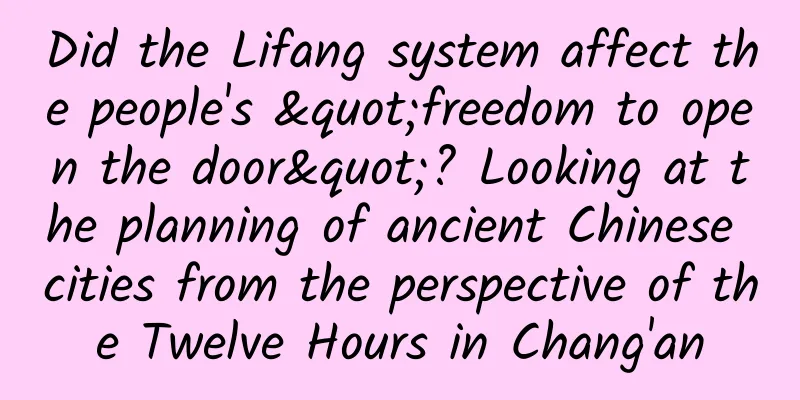Did the Lifang system affect the people's "freedom to open the door"? Looking at the planning of ancient Chinese cities from the perspective of the Twelve Hours in Chang'an

|
one Seen from the ancient Tang Chang'an The past and present of the “Lifang system” You can see that the streets and alleys of Chang'an, the capital of the Tang Dynasty, are very neatly arranged, crisscrossing each other, and divided into blocks like a chessboard. This is called the "Lifang System." Each block is called a "li" or a "fang". According to historical records and archaeological research, the layout of Chang'an City at that time was roughly square. The northern end of the central axis was the imperial palace Taiji Palace, and later the Daming Palace was built to its northeast. The city was divided into blocks according to the Lifang system, with a total of 109 Lifangs (Figure 1, Chang'an City Plan). The roads in the city were straight and wide. The avenue on the central axis in front of the imperial palace was 150 meters wide, and other main roads were 120 meters wide. The narrowest road between Lifangs was 25 meters wide. It was magnificent and fully reflected the style of the capital of the Tang Dynasty. Figure 1, Plan of Chang'an City in the Tang Dynasty (cited from Fu Xinian's History of Chinese Science and Technology, Architecture Volume, published by Science China Press in 2008) two Urban planning in ancient China The inheritance and development of the Nine Classics and Nine Latitudes Ancient China attached great importance to urban planning and urban management. Relevant systems had been in place for a long time and were passed down from generation to generation, with only some modifications and changes in each dynasty. The earliest and most complete urban planning system in ancient China that can be seen is the system of ancient royal city planning in the "Kaogongji" of the Spring and Autumn Period. Since "Kaogongji" is an official book issued by the court, it can be concluded that China has regarded urban planning as one of the contents of the country's political system since ancient times. Later facts also proved that urban planning in all dynasties, especially the planning of the capital, was written into the court's political system. The planning of the royal city in Kaogongji is as follows: " The craftsmen built the country, which was nine li square with three gates on the sides. The country had nine longitudes and nine latitudes, and nine tracks along the main roads. On the left was the ancestral temple, on the right was the community temple, facing the market behind, and the market was the only one in the front. " Figure 2: Planning map of the royal city in "The Book of Zhou: Kaogongji" "Guo" refers to the capital of the vassal states, which means: The craftsmen built the royal city in a square plane, nine li on each side, with three city gates on each side. There were nine longitudinal roads and nine transverse roads in the city, and the width of the main road was nine tracks (the width between the two wheels of a car was "one track"). To the left of the imperial palace was the ancestral temple for ancestral worship, to the right was the altar of land and grain, in front was the court meeting place, and in the back was the market. The market and the court meeting place each occupied a square of 100 steps (a square with a side of 100 steps was called "one fu"). Although there are not many cases in which the later urban planning completely complies with the system of Kaogongji, some key points of the capital city planning are influenced by the basic ideas of Kaogongji. Among them, the planning method of "Nine Classics and Nine Latitudes" has the greatest influence on later generations. The so-called "lifang system" should have originated from the planning method of "nine meridians and nine latitudes". In fact, few cities in later generations were actually planned according to nine longitudinal roads and nine transverse roads, but the use of longitudinal and transverse roads to divide the city into a grid was the main method of urban planning in ancient China, and it lasted for thousands of years . III Changes in the urban management system The rise and fall of the “Lifang system” The "Lifang System" is not only an urban planning method and planning system, but also an urban management system . The Lifang was surrounded by high walls, with a gate on each side, called the "Limen" or "Fangmen". It was closed at night and no one was allowed to go in or out. It was closed at dusk and opened at five o'clock in the morning. A curfew ("night ban") was imposed in the city. No one was allowed to walk on the streets at night, and the army patrolled. Anyone who went out at night and violated the "night ban" would be "beaten with a stick". Historical records show that someone was beaten to death for violating the night ban. With such a strict system, people did not lock their doors at night, thieves were not rampant, and public security was excellent . This was the city management at that time, and it can be seen that the city planning at that time also started from the management of society. Another aspect of urban management at that time was to control the development of commerce. Ancient China was founded on agriculture, and the policy of "focusing on agriculture and suppressing commerce" was implemented for a long time in history, encouraging agriculture and suppressing the development of commerce. The Lifang system was an urban management system formulated to cooperate with this policy . Shops were not allowed to be opened along the streets around the Lifang, and residents in the city could only buy things in designated areas and at designated times. This was the "market". In the Tang Dynasty, Chang'an City had "East Market" and "West Market" as places for buying and selling transactions (see Figure 1). There were 120 shops in the East Market, with all kinds of goods; there were "Hu merchants" in the West Market, shops opened by foreigners, which showed the openness and internationalization of Chang'an in the Tang Dynasty . However, even in the "market" dedicated to buying and selling, you could not buy things at any time. You could only buy and sell between the morning "drum" opening and the afternoon "gong" closing. The rest of the time, it was closed. It is said that the term "buying things" today came from this historical origin. There were "East Market" and "West Market" in Chang'an City. You had to go there to buy things. Over time, people got used to calling it "buying things". From this we can imagine the city life at that time, with high walls on both sides of the road and no shops. People could not go out at night, and there was no entertainment and nightlife like today. People could only go to bed early, "early to bed and early to rise makes a healthy body." The Lifang system lasted for thousands of years in China and reached its peak in the Tang Dynasty. The decline of the Lifang system began in the middle and late Tang Dynasty and was officially abolished during the Qingli period of Emperor Renzong of the Song Dynasty . The main reason for the disappearance of the Lifang system was the development of commerce. Commercial development depends on the market. The system of prohibiting shops along the street and prohibiting people from going out at night, as the Lifang system does, is obviously not suitable for the development of commerce. In fact, the Lifang system was originally formulated to suppress the development of commerce. With the development of society, people gradually realized the economic benefits and improvement of life brought by commercial prosperity, and there was a need to break the Lifang system and change the living conditions in the city. Political control could not resist the economic temptation . In the middle and late Tang Dynasty, the imperial power gradually weakened and the management gradually relaxed. Although there were still laws prohibiting it, the breaking of the Lifang system happened repeatedly. There are records in history books that some Lifang gates in Chang'an City did not follow the rules of opening and closing. Some were opened before the drum in the morning, and some were not closed until late at night. The rule that shops were not allowed to open in Lifang was also broken, and various shops were opened in some Lifang. In the late Tang Dynasty, the phenomenon of "invading the street" occurred. The so-called "invading the street" means that shops were opened in the residential areas within the neighborhood, breaking through the neighborhood walls, protruding to the side of the street outside the walls, and even opening shops facing the street. The Song Dynasty was the first peak of commercial development in Chinese history, and the prosperity of commerce exceeded that of any other dynasty in history. Although the Tang Dynasty was one of the most prosperous and powerful eras in Chinese history from a comprehensive perspective, the Song Dynasty was far more prosperous in terms of commerce and economy alone. The rulers of the Song Dynasty initially wanted to continue the traditional Lifang system, but they could not resist the requirements of commercial development. In the early Song Dynasty, there was a period of social contradictions caused by the issue of "invasion of the street". The rulers wanted to maintain the closed Lifang system walls, while urban residents wanted to break the walls and open shops on the street. The contradictions intensified, and the rulers had to make some concessions. When Emperor Huizong of Song Dynasty began to collect "invasion of the street corridor money", the taxation method was used to solve the problem, which was actually legalized. It can be said that this was the formal abolition of the Lifang system that lasted for thousands of years in ancient China . The walls of the past disappeared, replaced by shops lined up along the street, merchants came and went, the streets were crowded with traffic, and even night markets with bright lights all night long appeared, and the city's commerce was prosperous. We can get a direct impression of this kind of urban scene from a famous ancient painting - "Along the River During the Qingming Festival". "Along the River During the Qingming Festival" depicts the prosperous commercial scene in the Northern Song Dynasty capital Bianliang (now Kaifeng, Henan). Figure 3: Part of Along the River During the Qingming Festival IV Ancient and modern, Chinese and foreign, The “Lifang System” left these influences Although the ancient Lifang system disappeared with the development of urban commerce, its influence has lasted for a long time. In Japan, the influence of the Lifang system is very obvious . At that time, Japan learned from China in its entirety. The most famous capitals of ancient Japan, Kyoto and Nara, were built according to the Chinese Lifang system. Especially Kyoto (called Heijo-kyō in ancient times), was completely modeled after the planning of Chang'an City in the Tang Dynasty. Even the location of the imperial palace, the "East Market" and the "West Market", and even some names were modeled after Chang'an in the Tang Dynasty, such as "Suzaku Avenue" and "Suzaku Gate". Figure 4, Floor plan of Heijokyo (Kyoto), Japan (quoted from the Atlas of Japanese Architectural History compiled by the Architectural Society of Japan, newly revised edition published by Zhangguo Publishing House in 1996) Many years after the disappearance of the Lifang system, the Yuan Dynasty's Dadu (today's Beijing) and the Beijing city of the Ming and Qing dynasties that we can still see today were not strictly planned and built in the form of the Lifang system, but their urban layout followed the Lifang system. The vertical and horizontal road networks divided the city into many grid-shaped blocks. Today, the streets and alleys in the old city of Beijing still basically maintain the north-south and east-west grid pattern. The difference is that there are no more walls to control people's entry and exit and control commercial activities. It just borrowed the planning method of the Lifang system, but did not continue to use the management system of the Lifang system . In the folk, Lifang, as the concept most closely related to people's living, has long remained in people's minds, so much so that in our language today there are still many commonly used words such as "neighborhood", "lilong", "neighborhood", "fangjian", etc., all of which are derived from the concept of "Lifang". In addition, some Limen and Fangmen are still preserved in many traditional cities and towns, which are obviously the remains of the ancient Lifang system in people's minds. Figure 5: Jiuruli Gate, Changsha Figure 6: The gate of Wenrufang in the Three Lanes and Seven Alleys of Fuzhou Here, the inner gate or the square gate no longer has any function of controlling people's entry and exit. It is simply a symbol built by people out of their sense of identity and intimacy with the small area where they live. |
<<: How precious are the "parent seeds" targeted by foreign spies? Seed source safety is a big deal
>>: As fruits become sweeter, are they still the “spokespersons” of health?
Recommend
9 questions and 9 answers! There is a kind of pain called "herpetic neuralgia"
Produced by: Science Central Kitchen Produced by:...
How to do Valentine's Day marketing? Here are 6 tips for you!
Is Valentine’s Day Marketing Important? This time...
The new 4C rule: How to ignite a community at low cost?
As the saying goes, "He who controls the com...
Sleeping is the same as not sleeping! "Fragmented sleep" has become a hot topic! What should I do?
How's your sleep? In recent days, there have ...
Tiantian Dongting, who died with hatred, linked a past of grievances and entanglements
Yesterday, Alibaba announced that Ali Planet, a &...
When netizens said that WeChat plagiarized MiTalk, how should we understand the “Hehe” response from Tencent’s public relations director?
In recent times, Tencent’s public relations direc...
Tips for cold start operation and promotion of Tik Tok account!
“It’s hard to create a new Douyin account now!” R...
The person who loves nature the most also becomes the biggest killer
Lionel Walter Rothschild is from the Rothschild f...
Alibaba CTO Wang Jian: The era of computing economy has arrived!
Rethinking cloud computing This is the first time...
There is no light in the deep sea, so the eyes of animals have degenerated? In fact, they are all masters of using light
There are many kinds of life on Earth, and the un...
Volkswagen to build battery factory in Germany for pure electric Golf
In fact, this is not big news. Daimler is also bu...
Is the crash rate of iOS higher than that of Android? Data from Tingyun tells you the truth
The rapid development of mobile Internet and smar...
Why do humans like to pick their feet?
What do the guys who pick their toes around you l...
WeChat Moments traffic generation and promotion, how to promote yourself in WeChat Moments?
As WeChat has tens of thousands of users, it has ...
iOS understands multithreading from a practical perspective
Preface I believe that many developers have more ...









